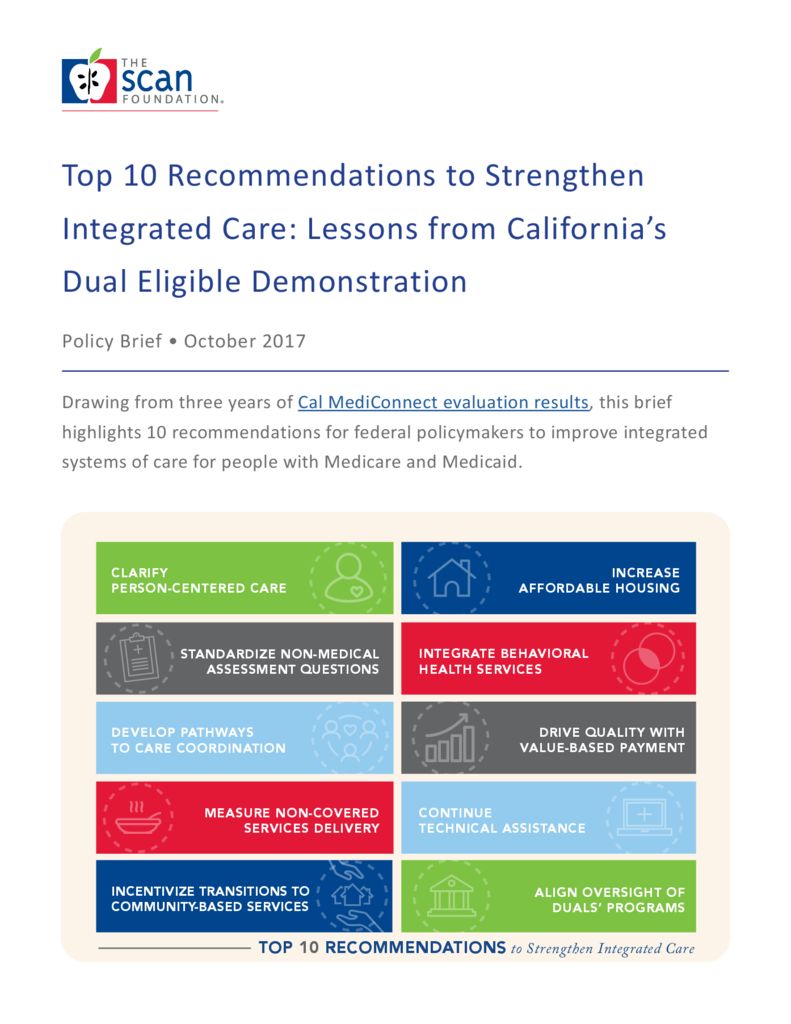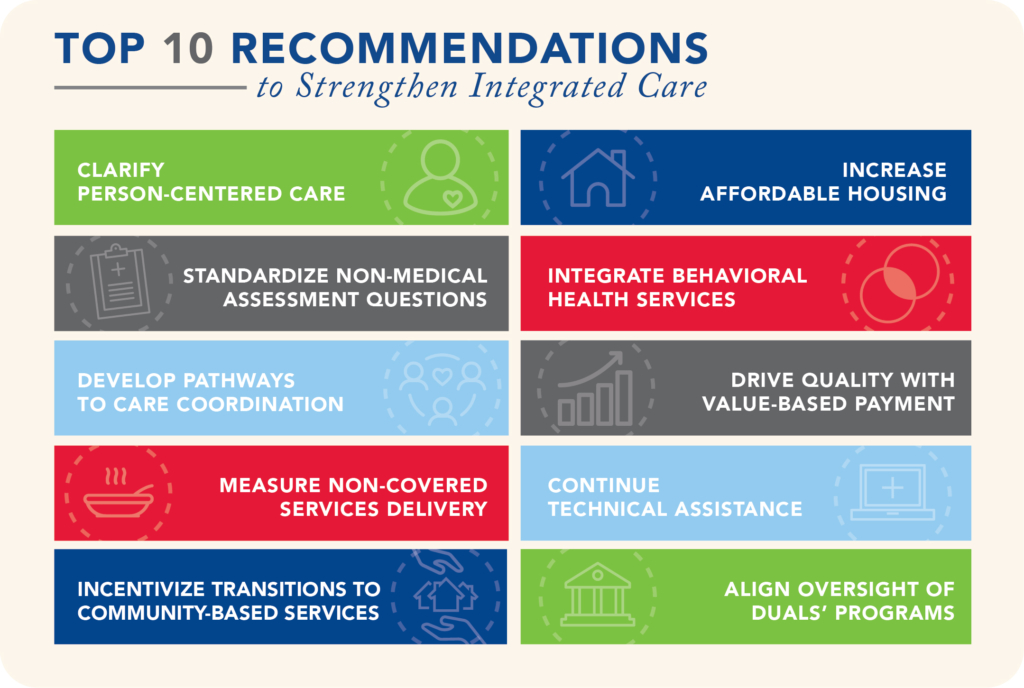Top 10 Recommendations to Strengthen Integrated Care: Lessons from California’s Dual Eligible Demonstration
summary
Read the Foundation’s top 10 recommendations for improving integrated systems of care for people with Medicare and Medicaid, also known as dually eligible individuals.
Date Updated: 09/29/2017Drawing from three years of Cal MediConnect evaluation results, this brief highlights 10 recommendations for federal policymakers to improve integrated systems of care for people with Medicare and Medicaid.
Introduction
California is one of 12 states implementing dual eligible demonstrations and has the greatest number of enrollees—over 116,000 dually eligible individuals in seven participating counties.1 California’s demonstration, called Cal MediConnect, integrates all Medicare and Medicaid services into one health plan, including long-term services and supports (LTSS).
The SCAN Foundation is funding rapid cycle polling and a broader evaluation of Cal MediConnect to better understand how people are experiencing care and identify areas for improvement. Results provide point-in-time information and perspective on whether beneficiary experiences change during Cal MediConnect’s implementation. Results have been used for program improvement by California’s officials and participating health plans, as well as shared across all demonstration states.
Findings show that Cal MediConnect is working well for beneficiaries who enroll; perceptions of the program improve the longer someone participates; and health systems are identifying promising practices as well as areas for improvement.2,3 Drawing from three years of Cal MediConnect evaluation results, this brief provides 10 recommendations for federal action to improve integrated systems of care.
Recommendations
- The Centers for Medicare & Medicaid Services (CMS) should provide clear guidance to states on the scope and minimum requirements of person-centered care. Systems that incorporate person-centered care characteristics address what matters most to individuals receiving services, such as balancing complex care needs with individual daily living goals. Person-centered care is a core component of the duals demonstration, yet there is no common framework used across states. In 2016, the Journal of the American Geriatric Society published a definition of person-centered care along with eight key characteristics.4 Additionally, four Essential Attributes, identified by an expert working group, provide a framework of a high-quality system of care for adults with complex care needs that operationalizes person-centered care.3,5 CMS has provided guidance for person-centered planning for Medicaid funded home- and community-based services.6 CMS should use the above resources to develop clear federal criteria on the scope and minimum requirements of person-centered care as further guidance to states, allowing flexibility on how the criteria are met.
- CMS should develop standardized assessment questions addressing non-medical needs for inclusion in health plans’ health risk assessments (HRAs). In a high-quality system of integrated care, an individual’s medical and non-medical (e.g., functional and social) needs and goals are identified, and the first touchpoint for this information is the mandatory HRA.3,5 California’s Department of Health Care Services recently required plans to include 10 questions in their HRAs to identify functional and social support needs.7,8 Learning from California’s experience and findings from a 2014 Avalere report, more can be done to use the HRA to elicit an individual’s goals and values as part of the process.9 In 2016, MACPAC reported that there are currently 124 functional assessments in use across states.10 As work to standardize use of functional assessment tools progresses, CMS should have a minimum set of core questions on function and other non-medical needs incorporated into HRAs, building a process to coordinate these responses with other important health-related information.
- Health plans should use all assessment information to identify risk and develop clear pathways to care coordination for beneficiaries who need it most. The Bipartisan Policy Center reported that individuals dually eligible for Medicare and Medicaid are more likely to experience complex care needs, have significant functional and cognitive impairments, and have greater need for care coordination.11 One element of person-centered care is having a care manager who serves as a single point of contact, arranging all aspects of care (i.e., medical and non-medical).5 The California evaluation shows that care coordination provided in Cal MediConnect is working well for those who receive it, yet there is no clear pattern as to who receives it.2,3,12,13 Only about one-third of enrollees report having access to a care manager (e.g., nurse, social worker, other health plan helper) as a single point of contact. Conversely, some individuals may have multiple care managers connected to specific programs, creating confusion and duplication of services.12 Developing clear roles and lines of communication can help alleviate confusion between health plans, state programs, and community-based providers. CMS should develop incentives to ensure health plans establish protocols to identify and reach out to high-risk beneficiaries through use of an enhanced HRA (described above) and designate a lead care coordinator to better manage critical care transitions and support coordination more broadly.9
- CMS should better define opportunities, incentives, and parameters for health plans to provide non-covered services. Cal MediConnect plans can provide optional services (e.g., home modifications, housing support, certain medical equipment), beyond plan benefits to help individuals avoid higher levels of care. Assessing their benefit to individuals and the system-level return on investment is challenging as neither Medicare nor Medicaid have codes for documenting and tracking these services, which may be provided outside the health plan by delegated providers.3 A recent report from the Center for Health Care Strategies proposes a definition of value-added services, strategies for providing such services, and potential policy solutions. CMS should develop a clear structure and process on optional services, as well as capture data to use for more accurate ratesetting methodologies while providing states and health plans the flexibility to meet the needs of individuals.14
- CMS should increase incentives for health plans to help transition long-stay nursing home residents to community-based settings. Transitioning individuals from institutional care to home- and community-based services provides an opportunity for improved care experience and cost savings. In Cal MediConnect, most health plans are interested in helping individuals transition back to the community, but encounter barriers in doing so. Creating incentives and improving payment structures could help increase successful transitions. One such option is for CMS to include payments for non-covered services associated with transitions in the medical loss ratio calculation, so those expenses are taken into consideration in the rate setting process.15
- The U.S. Department of Housing and Urban Development (HUD) and CMS should promote strategies to increase the availability of affordable housing options to expand successful transitions into the community. Accessing affordable housing is a significant barrier to community transitions. While Medicaid does not fund housing directly, flexibility exists for it to fund housing-related services (e.g., moving costs, supportive services, home modifications).15 In 2015, 37 of 44 states participating in the Money Follows the Person (MFP) demonstration reported implementing at least one strategy to address housing challenges.16 MFP has successfully shown how the right supports can help people transition into the community, but funding for this program is winding down. CMS and HUD should partner to create opportunities for states to further develop affordable housing options, building off of the lessons learned from MFP, demonstration waiver programs, and strategies shared in the Innovation Accelerator Program.17
- CMS should develop a framework for states and health plans to develop systems that integrate behavioral health services for a seamless care experience for individuals. In California, specialty behavioral health care is provided by the counties, and mild-to-moderate behavioral health needs are addressed by the health plans. Counties use different definitions for these two levels of care, causing confusion and challenges to coordinating services. However, some Cal MediConnect plans have successfully increased access to provide more care choices for beneficiaries. Integrated systems of care should more seamlessly integrate behavioral health by investing in relationship building, shared learning, and collaboration with behavioral health service providers. CMS should continue to test innovations to identify more efficient strategies for integrating and coordinating medical care, LTSS, and behavioral health.18,19
- CMS should drive refinement of dual eligible integration models through use of value-based payment using a streamlined and relevant set of quality measures. Payment should be aligned with quality measures that address what matters most to people, driving care to be delivered in a person-centered manner. In Cal MediConnect, incentives to improve quality of care resulted in plans increasing quality oversight of providers. However, the increased collection and reporting of quality metrics connected with Cal MediConnect also creates burdens for both health plans and providers. Several health plans report that even though CMS tried to select data collection and reporting requirements already used in Medicare and Medicaid, these requirements are not aligned, and therefore additive or duplicative. Additionally, LTSS and behavioral health providers working with multiple health plans found the variations in reporting processes burdensome.3 CMS should address the quality measurement reporting burden by gathering input from stakeholders as to which measures have the most impact, and aligning quality measures across payers.
- CMS should continue offering mechanisms to foster best practices and provide technical assistance for integrating care. Valuable resources, planning, and technical assistance support has been provided to states as they work to integrate care for dually eligible individuals. Through mechanisms like the Integrated Care Resource Center, Medicaid Leadership Institute, and Demonstration Ombudsman Learning Collaborative, states have been able to share best practices, problem solve, and receive coaching to develop and implement integrated systems of care. CMS should continue this support to help early and late adopting states learn from each other and continue to build high-quality systems of integrated care.
- CMS should align the implementation and oversight of programs serving individuals dually eligible for Medicare and Medicaid. People access health care and LTSS through a number of delivery systems including Medicare, Medicaid, and federally funded community-based programs. These delivery systems were created separately, and the rules and regulations guiding these systems are not aligned. This creates challenges for coordinating services in an effective and efficient manner.3 A recent Bipartisan Policy Center report recommends aligning administrative and program standards and processes to improve access to health care and LTSS. Aligning coverage standards for benefits that overlap, such as durable medical equipment and home health services, will diminish barriers and increase efficiency. CMS professionals with experience in both Medicare and Medicaid should administer and oversee programs serving dually eligible individuals to ensure that decisions and oversight are integrated.20
Download the publication for all visuals and complete references.
Continue Reading
This is the third report coming from the California Medicaid Research Institute (CAMRI) project entitled: Comprehensive Analysis of Home- and Community-Based Services in California. The report describes Medicare and Medi-Cal spending for those beneficiaries using long-term services and supports funded by Medi-Cal.
The California Medicaid Research Institute (CAMRI) developed an integrated and longitudinal database containing Medi-Cal and Medicare claims and assessment data of LTSS recipients in California in 2008. CAMRI’s integrated database provides a unique opportunity to look at characteristics and program spending across the entire care continuum for beneficiaries with LTSS needs within Medi-Cal and for dual eligibles across Medicare and Medi-Cal. This report focuses on LTSS use and spending in the eight duals demonstration counties.
On March 27, 2013, the State of California and the Centers for Medicare and Medicaid Services (CMS) formalized a Memorandum of Understanding (MOU) to establish a Federal-State partnership to implement the Dual Eligibles Integration Demonstration, also referred to as Cal MediConnect. This Fact Sheet provides background information about Cal MediConnect and summarizes the key points of the MOU.



